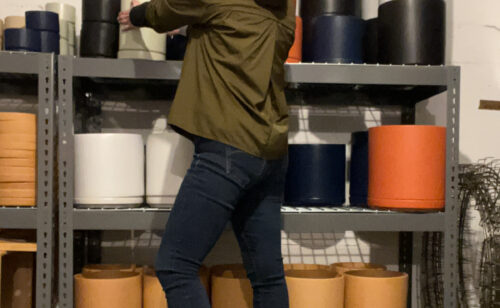Break the Feast + Famine Cycle: Economic Forecasting for Retail Shops

Today’s blog post comes to us from Katherine Raz, a guest expert in our community and the owner of Fernseed, a plant and flower shop in Tacoma, WA.
Welcome to the ultimate guide to economic forecasting for retail shops! I am sharing my top 10 resources to navigate the ever-changing landscape of retail to help you make informed decisions about staffing and stocking your shop.
Understanding seasonality and “micro seasonality” for retail shops
Four months after I first opened Fernseed, the plant shop I own that started in Tacoma’s high-foot-traffic Proctor District, we hit a sales slump. It was late August, 2019. We’d been exceeding my initial sales projections in the first few months of business, but now our monthly revenue was down by 10-15%. I was seriously worried that initial interest in my store had waned, that everyone in Tacoma who wanted to buy house plants had purchased them in those first months, and now we were finished.
I was pinning my hopes on the back-to-school season, when parents who drop their kids off at the nearby kindergarten would be wandering the neighborhood again, shopping for plants. But when the school down the street opened again in September, we saw no increase in foot traffic. I figured we were doomed. Going out of business.
One slow morning during the September slump, one of our regular customers, Sarah, wandered in. She worked down the street at the gift boutique that had occupied the neighborhood for nearly a decade. She asked how things were going and I told her, “Terrible. I think we’re done!” I expressed my concern that the back-to-school parents hadn’t returned.
She nonchalantly answered, “Oh, this time of year is always dead.”
Really?
“Totally! People are spending money on school supplies and figuring out new routines,” she explained. “It’ll be dead for a couple of weeks. Picks up again in October.”
I wanted to hug her, the way you want to hug a doctor who tells you good news.
A few weeks later our sales picked up again.
It took me a year to figure out what our sales cycles were. I opened my retail shop understanding the concept of seasonality, but until I actually stood behind a cash register every day, it didn’t occur to me how rapidly revenue fluctuates. For example, while October is a strong month for sales, the week before Halloween is slow because everyone is buying costumes and candy. Your micro seasonality is not only dependent on universal seasonal shopping patterns, it’s hyper-local to your area. In Chicago, foot traffic doesn’t stop when it snows. In Tacoma, no one leaves the house.
I jokingly refer to these micro fluctuations as “The Retail Book of Reasons,” like the Farmer’s Almanac for brick-and-mortar stores. “We should write these all down!” I always say. “Then we’ll remember next year and we won’t panic.”
Understanding longer-term sales slumps
But I have to admit I am panicking a little right now. While the seasonality of Retail Book of Reasons remains consistent, our overall sales are down ~30-40% the past two years. Same seasonality, less overall money coming in.
I figure it’s the tech layoffs (and our proximity to Seattle), and probably a recession (looming or already here). But I can’t help the tendency to get catastrophic. Are we doomed? Is the plant trend over? Was this a flawed business idea to begin with?
Large corporations have entire departments dedicated to economic forecasting. As independent retailers, we have only ourselves. If our sales are down 30-40% from one year to the next, we have just as much obligation to understand why as the big players. Understanding the forces behind slow sales is the key to making smart decisions that keep us in business. But where do we go to get high-level economic insight?
10 places independent shops can go to get economic insight
1. Talk to your suppliers
No one has a more direct relationship to your geographic region and industry than the people you buy product from. Your major suppliers are working with 100 other shops just like you, so they are more than qualified to tell you where you stand in relation to the rest of the industry. People, especially sales people, love being asked for their industry insight, and bonus: they want to see you succeed! So they will give you the facts (anecdotal as they may be), but they may also be able to share ideas about what other shops are doing to make ends meet in an economic downturn.
2. Chat up the delivery people
Delivery drivers who work in-house at your suppliers (versus 3PL or LTL carriers) have a direct relationship with volume. They are literally packing, driving, carrying and unloading every object that leaves the warehouse! I make it a regular practice to check in with our drivers about what they’re noticing in the industry. Are sales up or down? What’s volume like right now? I heard XYZ shop is closing, do you know what happened? I’ve gotten so much useful information from these conversations, especially from drivers who have been with their companies for a long time. They remember the trends!
3. Analyze software benchmarking tools and free content
Both Shopify and Klaivyo offer benchmarking data pulled from thousands of their own users. A quick check of Klaviyo’s blog offers a useful insight: larger marketing budgets will increase in 2023, while smaller marketing budgets will shrink. This makes me think that smaller shops are feeling the pressure more than larger businesses. Shopify recently released benchmarking data as part of some of their built-in reports. The one I find most useful is the average order value. By comparing our AOV against industry benchmarks, I can see where we stack up. At the end of 2022, our AOV actually increased compared with industry peers in our 25th percentile group.
4. Talk to other business owners, both locally and in the same industry
In my four years in business, I’ve made connections with a handful of shop owners in Tacoma and a couple plant shop owners in other areas who I can reach out to for real talk about business ownership, including revenue. In recent months I’ve reached out to those people in my network who have confirmed I’m not alone in declining sales. It’s not great news, but at least it’s a shared problem, so I know my problem-solving should be focused on weathering a financial downturn (shared problem) versus fixing a flawed business model (solo problem).

5. The Cardboard Box Index
In potentially the most validating and eye-opening data analysis I have ever done, I recently compared Fernseed’s lifetime sales against the cardboard box index, a report generated by the U.S. Federal Reserve that tracks the production of—you guessed it!—cardboard boxes. According to Investopedia, “The cardboard box index refers to the idea that an increase in the production of cardboard boxes is a leading indicator that goods manufacturing will increase, or that a decline in cardboard box production signals a manufacturing slowdown.” In other words, the more boxes being produced, the greater the demand for consumer goods. I had a hunch that our sales would correlate with the cardboard box index, but I am absolutely shocked at how direct the relationship is. This once again confirms my suspicion that we are not alone in experiencing a dip in sales.
6. Look at retail earnings reports for several public companies in your sector
Here is a place to find companies by sector. I chose 3: 1-800-FLOWERS, 1stDibs, and Williams Sonoma. To find their revenue reports, go to Financials > Income Statement. There you can see the company’s sales plain as day!
7. Go to trade shows or talk to line reps
At big trade shows you’re likely to find companies big enough to have access to formal industry data and predictive analytics. Ask them about it! Go to the biggest booth, the one that takes up 20,000 square feet. Find a brand rep with an iPad. Tell them you’re interested in any sort of data or analytics their company collects or relies on. Remember that these people are using the data to figure out what products to manufacture, a huge upfront expense. They use data to tell them not only how many products to make based on current economic factors, but what to focus on based on marketplace trends.
8. Trade magazines and trade media influencers
Trade magazines conduct and publish surveys all the time. Some of them you have to pay for, but you might also be able to get access at a public or college library. That said, I have always found retail surveys to be slightly out of touch, as they aggregate data that often doesn’t apply to independent shops. So rather than just looking to the larger trade media (eg. the National Retail Federation), try to find smaller influencers within your sphere. For example, at Fernseed we follow the Slow Flowers movement. Founder Debra Prinzing does an amazing job surveying the organization’s membership and publishing findings that are much more relevant to our business. I encourage you to make a list of your own important industry influencers and pay attention to their surveys and trend reports!
9. Participate in your local chamber of commerce and neighborhood associations
I have been terrible at attending chamber and neighborhood events since COVID, dismissing them as “peacetime activities” I don’t have time for. But the connections and resources I get from these groups are invaluable. It’s a reminder that the city and neighborhoods value the business I’ve built, and want to see it stick around. Not every meeting or event provides the exact answer I need, but my involvement is a bridge to the information and support I probably need.
10. Talk to your local bank
I’m fortunate to have a local bank that knows me. I’m talking they call me up when I bounce a check. Their bankers reach out to me to ask how I’m doing. Yes, they’re offering new products and selling me things, but bankers are like suppliers in that they have relationships with lots of local businesses, so if you have good relationships with your bankers you can ask: am I alone here in needing to extend my line of credit just to make payroll? Are you seeing other businesses struggling right now? My two favorite bankers have real sit-down conversations with me that include anecdotal “reports” on the state of their other retail clients (not named by name of course). I encourage you to find a local bank with real people you can talk to.
Now you’re armed with a bit more information, which means you have a clearer picture of how to navigate economic forces that may not be within your control. Looking at these figures I realize: it’s not just me. But what does that mean in the immediate? It means I should spend time figuring out how to operate on limited revenue, creating and sticking to budgets, finding creative ways to reward my team, and encouraging sales from our consistent customers (those who may not be affected by the economic downturn). It also means I should not panic, assume we’re going out of business, discount my products beyond reason, or market to customers who aren’t likely to spend money right now anyway. In other words: knowing this information helps me create a plan, manage uncertainty, and focus on the big picture.
I’d love to know what resources you use to gather information about the economy or your industry! Feel free to include them in the comments.
If you own and operate an independent retail shop, I encourage you to subscribe to my newsletter, Storefront Revolt. You’ll get twice-monthly missives from me about the things I’m working on, thinking about, collecting, and advocating for in the course of running my shop. You can always email me directly at katherine@thefernseed.com with your thoughts, questions, and comments.
Brick & Mortar Economics 2022

How do you run a retail shop that prices right, treats employees well, is community minded, and still makes a profit?
Browse Posts
Newsletter Sign Up
We write a new email each week to help you grow your business.
Related Posts
Let's take your online shop to the next level
The Shopify websites we design have a reputation for substantial improvements to ecommerce conversion rates and online sales. Let's talk!
 Grab my guide to the 10 main ways to grow traffic and optimize to boost sales.
Grab my guide to the 10 main ways to grow traffic and optimize to boost sales.


